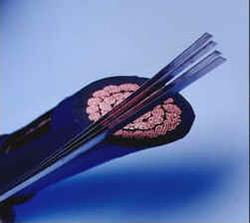The Shadow of Superconductivity

The dreams of cheap electric power and magnetically levitated trains have faded a bit since the discovery of high-temperature superconductivity (HTS) over a decade ago. But physicists are still trying to explain the phenomenon, and many believe important clues lie in a curious trait of some of these materials: Several properties normally seen in superconductors persist up to very high temperatures, into the normal (nonsuperconducting) state. One central question is the relationship of these properties with those of the superconducting state. A report in the 4 January PRL suggests that at least one of the properties, measured with nuclear magnetic resonance, is not as closely tied to the superconducting state as other researchers have claimed. The results may give some hints on which theories of HTS are correct.
Superconductors are rated by the critical temperature below which they carry current without resistance. An “underdoped” sample, such as is made with a slight oxygen deficit, so that is perhaps only 60 K, compared with 93 K for optimally doped samples. These less-than-perfect superconductors have a remarkable property: As the temperature is reduced from near room temperature (300 K), they show signs of the superconducting state, even though their conductivity is ordinary. One classic sign of superconductivity is the “energy gap”–a range of energy levels that are forbidden to electrons, with all states below the gap completely filled. In conventional low-temperature superconductivity the presence of this gap signifies the sudden transition at but underdoped high-temperature superconductors show the onset of a gap far above where it’s called a pseudogap. Theorists hope that understanding this shadow of the superconducting state will shed light on the mechanism for HTS.
One direct indication of the energy gap is the value of the spin relaxation time which measures the ability of nuclei to exchange energy with conduction electrons–a process that is strongly suppressed by the existence of a gap. So underdoped materials show an anomalous drop in 1/ as temperature is reduced, which signals the formation of the pseudogap. Researchers would like to know if this transition, which begins in the normal state, is connected to the superconducting transition.
Chris Hammel of Los Alamos National Laboratory is the leader of a team that studied this question with what team member Charles Pennington of Ohio State University calls a “simple minded” experiment: Artificially lower by applying a large magnetic field–a common trick in superconductivity research–and check if the curve for moves with Previous data were contradictory, with some researchers seeing a significant shift downward and others seeing an upward shift. Hammel and his colleagues used nuclear magnetic resonance to measure in magnetic fields up to 14.8 T, enough to lower by 8 K. With high precision they found the steep drop of 1/ was unaffected by the field and continued straight past the zero field value of which “rules out the possibility that this is a precursor to the superconducting gap,” according to Hammel. The team attributes the contradictory reports to some technical complications caused by powdered samples–problems they overcame by observing a different set of nuclear transitions.
The results suggest that “the pseudogap is really something independent from the superconducting transition,” says Patrick Lee of the Massachusetts Institute of Technology. One school of HTS theories contends that the pseudogap comes from short-term fluctuations of the material properties, so that small regions become superconducting above for short times. But Lee says that at least the simplest of these theories are disproven by the new results because such fluctuations should be very sensitive to changes in On the other hand, Pennington cautions that although several theorists have assured him the measurement is important, none have yet published precise predictions for this experiment.


